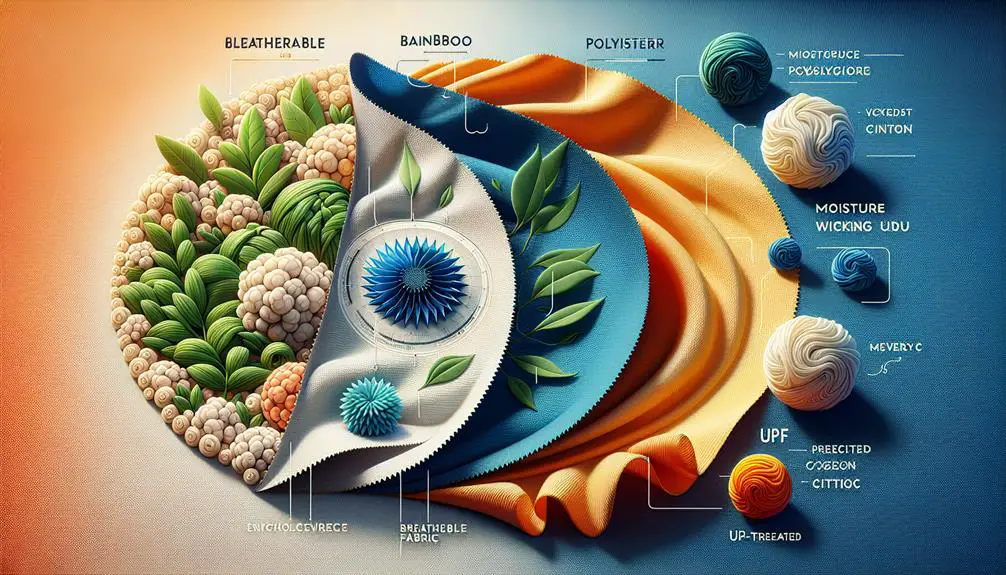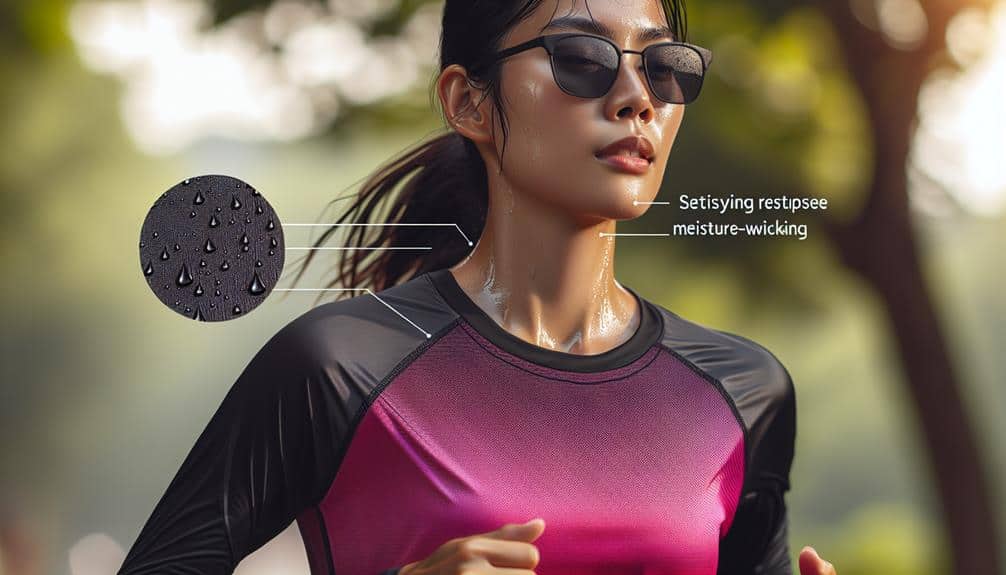When selecting UV-protective materials for breathable clothing, prioritize fabrics with high UPF for maximum sun defense. Opt for tightly woven options like polyester or nylon in darker shades for increased UV blockage. Guarantee durability to maintain UPF levels and consider UV-absorbing treatments. Look for advanced technologies like cooling features and antimicrobial finishes for added comfort. Choosing moisture-wicking fabrics enhances dryness and comfort during outdoor activities. The right fabric properties can make a significant difference in sun protection and wearability.
Key Points
- Polyester: Excellent UV protection with moisture-wicking properties for breathability.
- Nylon: Durable fabric that offers UV protection and moisture-wicking for comfort.
- Merino Wool: Natural UV resistance and moisture-wicking for breathability.
- Polypropylene: Exceptional UV protection and cooling performance for outdoor activities.
- Sustainable Options: Recycled fibers or organic cotton with UV protection for eco-conscious choices.
Benefits of UV-Protective Fabrics
When considering UV-protective fabrics, it's imperative to understand the tangible benefits they offer in shielding against harmful ultraviolet radiation. These fabrics provide essential health benefits by reducing the risk of skin cancer, premature aging, and other skin damage caused by UV exposure. By blocking a significant portion of the sun's harmful rays, UV-protective fabrics act as a reliable barrier between your skin and potential harm, ensuring you can enjoy outdoor activities without compromising your health.
Moreover, UV-protective fabrics aren't just about protection; they also cater to modern fashion trends. With advancements in textile technology, these fabrics are now available in a wide range of styles, colors, and designs, allowing you to stay stylish while safeguarding your skin. This integration of health benefits with fashion trends has made UV-protective clothing a popular choice for those who prioritize both protection and style in their wardrobe.
Popular Moisture-Wicking Textiles
Popular moisture-wicking textiles are highly sought-after for their ability to efficiently draw sweat away from the skin, keeping you dry and comfortable during physical activities. When selecting moisture-wicking fabrics for your UV-protective clothing, consider the following key options:
- Polyester: A common choice for moisture-wicking garments due to its excellent moisture management properties and quick-drying capabilities.
- Nylon: Known for its durability and moisture-wicking properties, making it a reliable option for activewear.
- Merino Wool: Provides natural moisture-wicking abilities along with odor control, making it a great choice for outdoor activities.
- Polypropylene: Offers exceptional moisture-wicking properties and cooling performance, ideal for intense workouts in hot conditions.
These textiles not only keep you dry by moving sweat away from your body but also help regulate temperature and prevent the buildup of odor, enhancing your overall comfort during physical exertion. When combined with UV-protective features, these fabrics create a functional and comfortable solution for outdoor enthusiasts seeking high-performance apparel.
Considerations for UV-Resistant Garments
Considering various factors is vital when selecting UV-resistant garments to ensure excellent protection against harmful sun rays. When contemplating UV-resistant garments, concentrate on the UV blocking properties of the fabric. Seek materials that provide a high Ultraviolet Protection Factor (UPF) rating, indicating the level of protection against UV radiation. Fabrics with tighter weaves or darker colors typically offer better UV protection. Moreover, lightweight designs are essential for comfort and breathability, particularly in hot weather. Choose fabrics that aren't only UV-resistant but also lightweight to guarantee ease of movement and ventilation.
When choosing UV-resistant garments, prioritize functionality without compromising on protection. Assess the design features such as long sleeves, high collars, or adjustable hoods that can improve coverage and shield more skin from the sun. Keep in mind that proper garment care, including regular washing and maintenance, can help maintain the UV protection properties of the fabric. By considering these factors, you can confidently select UV-resistant garments that offer excellent protection while keeping you comfortable and stylish.
Innovative Technologies in Sun-Protective Materials
Innovative advancements in sun-protective materials have revolutionized the UV-protection industry, enhancing fabric performance and durability against harmful sun rays. Manufacturers are constantly integrating cutting-edge technologies to improve the functionality of sun-protective clothing.
Here are some key innovations to look out for:
- Cooling technologies: Some fabrics now incorporate cooling properties that help regulate body temperature, keeping you comfortable even in the heat of the sun.
- Sustainable options: With a growing focus on sustainability, eco-friendly sun-protective materials made from recycled fibers or organic cotton are becoming more prevalent.
- Moisture-wicking capabilities: Advanced fabrics have moisture-wicking properties that draw sweat away from the skin, keeping you dry and cool.
- Antimicrobial treatments: Certain materials are treated with antimicrobial agents to prevent odor-causing bacteria growth, ensuring your clothing stays fresh and clean even in sunny conditions.
These advancements not only provide superior sun protection but also enhance comfort and performance, making them ideal choices for those seeking high-quality UV-protective clothing.
Tips for Choosing UV-Blocking Fabrics
When selecting UV-blocking fabrics, prioritize those with a higher ultraviolet protection factor (UPF) to guarantee effective sun protection. Fabric selection plays an essential role in determining the level of UV protection offered by clothing. Opt for tightly woven fabrics like polyester, nylon, or denim, as they provide better UV protection compared to loosely woven materials. These fabrics create a barrier that blocks harmful UV rays from reaching your skin.
Durability is another key aspect to take into account when choosing UV-blocking fabrics. Look for fabrics that maintain their UPF rating even after multiple washes and prolonged sun exposure. Fabrics treated with UV-absorbing chemicals or dyes can enhance their sun protection properties.
In addition to UV protection, make sure the fabric offers comfort. Breathable fabrics like cotton or moisture-wicking materials help keep you cool and dry, making them ideal for prolonged sun exposure. Prioritize fabrics that offer a balance between UV protection and comfort to ensure you stay protected without compromising on wearability.
Frequently Asked Questions
Are Uv-Protective Fabrics Suitable for All Skin Types, Including Sensitive Skin?
When it comes to UV-protective fabrics, especially for sensitive skin, it's crucial to take into account potential skin reactions. While some materials may trigger allergies or irritations, advanced options are accessible to guarantee comfort and protection for all skin types.
How Does the UV Protection of Clothing Compare to Sunscreen for Sun Protection?
When comparing UV protection of clothing to sunscreen, consider clothing as a reliable alternative. Garments provide consistent coverage, unlike lotions that may wear off. Opt for UV-protective clothing for prolonged sun exposure.
Can Uv-Protective Clothing Lose Its Effectiveness Over Time Through Washing or Wear?
Over time, the fabric's durability may be impacted by washing and wear, potentially reducing its effectiveness against UV exposure. Regular maintenance and care can help preserve the UV-protective properties of your clothing for best protection.
Are There Specific Care Instructions for Maintaining the UV Protection of Garments?
To maintain UV protection in garments, follow specific washing instructions provided by the manufacturer to preserve fabric durability under UV exposure. Regular UV testing can guarantee effectiveness over time, preventing degradation from washing or wear.
Are There Any Potential Health Risks Associated With Wearing Uv-Protective Clothing for Extended Periods of Time?
Extended wear of UV-protective clothing may lead to potential risks like vitamin D deficiency due to limited sun exposure. However, balancing sun exposure is essential for health. Wear clothing with proper UV protection and manage sun exposure wisely.




